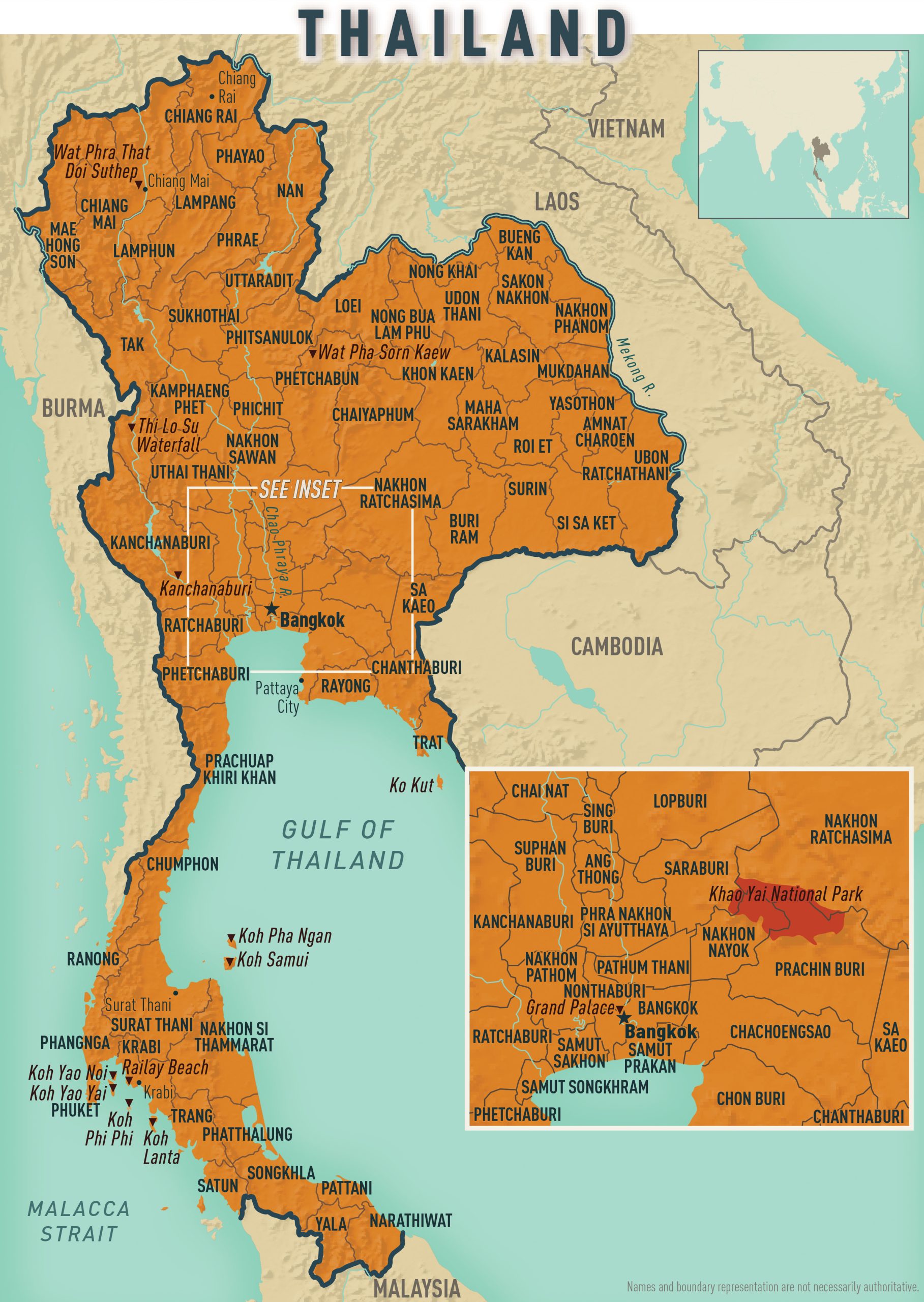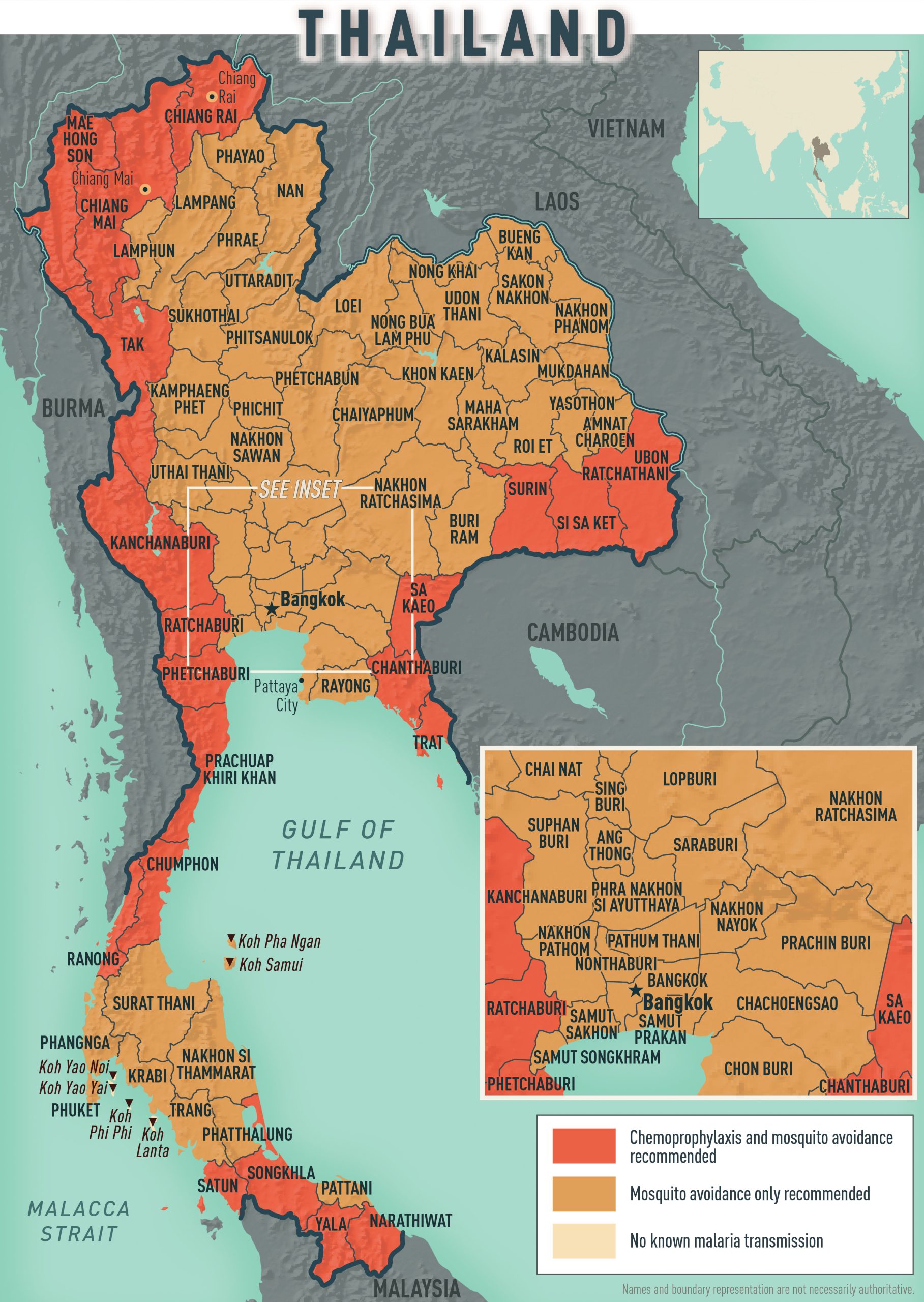Purpose

Destination overview
Thailand, a geographically diverse country a little smaller than the state of Texas (Map 11.3.4.1), is a popular destination for tourists, offering beaches, a wide range of cultures and cuisine, eco-adventure opportunities, nightlife, and shopping. Thailand is also a regional business hub. In 2019, approximately 40 million visitors spent >1 night in Thailand. Following COVID-19-related travel restrictions during 2020–2022, international travel to Thailand has resumed, with over 34 million visitors to Thailand in 2024.
Visitors to Thailand engage in a number of activities, including hiking in jungles, scuba diving and snorkeling, animal encounters, and visiting cultural sites such as temples and markets (Box 11.3.4.1).
Thailand's central location and major international airport in Bangkok make it an easy access point for other destinations in Asia. In addition, the country has become a popular retirement destination for people from around the world, including many U.S. citizens. The warm climate and low cost of living make Thailand an attractive place to live.
Map 11.3.4.1

Centers for Disease Control and Prevention
Box 11.3.4.1
Infectious disease risks
All travelers should be up to date on their routine vaccinations, including measles and seasonal influenza. In addition, vaccination against hepatitis A, hepatitis B, and typhoid fever is strongly recommended. Japanese encephalitis (JE) vaccine may be appropriate based on the traveler's potential risk during a visit to, or longer-term residence in, Thailand. For current recommendations for travelers to Thailand, see CDC's Travelers' Health website.
Animal bites and rabies
Government-sponsored mass vaccination campaigns for cats and dogs have reduced the prevalence of rabies in Thailand, but a small risk persists. Pre-exposure vaccination is recommended for travelers whose occupation puts them at risk for exposure (e.g., veterinarians) or people who will be traveling to areas where immediate access to care and rabies biologics will be difficult (see Rabies chapter). Rabies vaccine for pre-exposure and post-exposure prophylaxis and human rabies immune globulin are readily available in all provincial and most district hospitals throughout Thailand.
Monkeys are found in many tourist destinations. In addition to carrying a risk of rabies, macaque monkeys can also transmit B virus (see Zoonotic Exposures: Bites, Scratches, and Other Hazards chapter), which can cause serious illness or death. Travelers should stay away from monkeys and make sure to not touch or feed monkeys. People who are scratched or bitten by an animal (e.g., cat, dog, monkey) while traveling should thoroughly wash and gently scrub the area with soap and running water for at least 20 minutes and seek medical attention immediately.
Enteric infections and diseases
Cholera
Rare sporadic cholera cases have been reported in recent years, with no outbreaks or active cholera transmission. Vaccine and antibiotic chemoprophylaxis are not recommended. Travelers should follow safe food and water precautions and frequently wash hands (see Food and Water Precautions for Travelers chapter).
Travelers' diarrhea
Thailand's street food is convenient, delicious, and inexpensive. Unfortunately, it also can be a source of travelers' diarrhea because a lack of clean running water in outdoor eateries precludes good hand and food preparation hygiene. For travelers determined to experience Thai street food, the risk for foodborne illness might be mitigated to some degree by following some basic food and water safety precautions. For instance, they should visit only restaurants or food stalls that cook food to order, avoid raw or undercooked food, eat only steaming hot food served on new disposable dishes, avoid raw garnishes, and eat fruit that they peel themselves. Bottled or filtered water is widely available; travelers should not drink water from the tap, only drink beverages from sealed containers, and avoid ice (see Food and Water Precautions for Travelers; for further information about travelers' diarrhea, see Travelers' Diarrhea chapter). Fluoroquinolone-resistant enteric pathogens are widespread in Thailand and other areas of Southeast Asia.
Typhoid fever
Typhoid fever was previously endemic to Thailand. Incidence was estimated to be 1.13 cases per 100,000 population in 2022. Vaccination is recommended for most travelers, especially those staying with friends or relatives or visiting smaller cities or rural areas (see Typhoid and Paratyphoid Fever chapter).
Respiratory infections and diseases
Coronavirus disease 2019
All travelers going to Thailand should be up to date with their COVID-19 vaccines.
Tuberculosis
Thailand has a high burden of tuberculosis (TB). Travelers who visit Thailand for extended visits, especially those who are immunocompromised, could be at increased risk for TB infection. Travelers should avoid people known to have active TB disease (see Tuberculosis chapter).
Sexually transmitted infections and HIV
Thailand is a destination for tourists seeking sex (see Sex and Travel chapter). Although commercial sex work is illegal, it is practiced in many places in Thailand, and these areas have been associated with human trafficking.
Thailand has experienced an increase in the number of clade II mpox infections since 2023, especially among gay, bisexual, and other men who have sex with men and people living with HIV. Transmission is primarily through direct skin-to-skin contact, frequently through sexual contact. Travelers who are eligible for vaccination should be vaccinated before travel and review other precautions on how to protect themselves against infection during travel. Treatment for mpox is available at some hospitals in Thailand.
In 2022, approximately 560,000 people were living with HIV in Thailand. The number of new HIV infections reported nationwide each year decreased during 2010–2022 to approximately 9,200 new infections in 2023. The 100% condom program established in 1991, which encourages sex workers and their customers to always use condoms, helped slow the spread of HIV and other sexually transmitted infections (STIs). Currently, HIV pre-exposure prophylaxis (PrEP) is the most effective prevention strategy to reduce HIV transmission. Nonetheless, HIV infection remains concentrated in many populations. In 2020, an estimated 12% of men who have sex with men and 3% of sex workers (4% of male sex workers and 1.7% of female sex workers) in Thailand were living with HIV.
Travelers should be aware of the risks of acquiring HIV and other STIs in Thailand, always use condoms during sex, and avoid injecting drugs or sharing needles. Antibiotic-resistant gonorrhea infections have been reported in Thailand. Thailand has a moderate burden of hepatitis B, which can be transmitted sexually. Since 1992, national hepatitis B vaccination has been implemented for newborns within 24 hours after birth, followed by booster doses at 2, 4, and 6 months old, resulting in low prevalence (<1%) in the Thai population below 30 years of age. Hepatitis B vaccination is recommended for all unvaccinated travelers before travel to Thailand. Travelers whose practices put them at high risk for HIV infection should discuss pre-exposure prophylaxis with their primary care or travel medicine specialists (see Sex and Travel chapter).
Soil- and waterborne infections
Leptospirosis and melioidosis
Leptospirosis (see Leptospirosis chapter) cases occur mainly in the southern and northeastern regions of the country; melioidosis is highly endemic to northeast Thailand. For both diseases, most cases occur during the rainy season, July–October. Adventure travelers can be at increased risk for these diseases because their activities expose them to soil and surface water. Advise travelers visiting endemic areas to avoid contact with potentially contaminated freshwater and flood waters and to ensure that any open wounds are covered to prevent exposure. When contact cannot be avoided, travelers should wear protective clothing and footwear to reduce their exposure risk. Chemoprophylaxis against leptospirosis with doxycycline (200 mg orally, weekly), beginning 1–2 days before and continuing through the period of exposure, can be considered for people at high risk and with short-term exposures. Counsel travelers to immediately and thoroughly clean abrasions, burns, or lacerations contaminated with soil or surface water.
Vector-borne diseases
Chikungunya, dengue, and Zika
Local transmission of chikungunya virus in Thailand has been reported (see Chikungunya chapter). Mosquito vectors that can transmit chikungunya virus, like Aedes aegypti and Aedes albopictus, can be found throughout Thailand. Travelers to Thailand should take measures to protect themselves from mosquito bites to prevent chikungunya, dengue, and Zika (see Mosquitoes, Ticks, and Other Arthropods chapter).
Dengue is endemic throughout Thailand (see Dengue chapter). Large epidemics occur every several years. Peak transmission is during the rainy season, although cases are reported year-round even in non-epidemic years.
Transmission of Zika virus occurs in Thailand (see Zika chapter). There are regular reports of travelers who acquire Zika virus infection during travel to Thailand, including cases of congenital infection. Because of the risk for birth defects in infants born to women infected with Zika virus during pregnancy, travelers who are pregnant or trying to become pregnant and their partners should review the most recent CDC recommendations.
Japanese encephalitis
JE is endemic to many parts of Thailand outside of Bangkok (see Japanese Encephalitis chapter). Transmission occurs year-round, with seasonal epidemics occurring in the northern provinces during May–October. Although most outbreaks occur in the Chiang Mai valley, cases have occurred in travelers who visited resorts or coastal areas in southern Thailand. JE vaccine is recommended for travelers who plan to visit Thailand for ≥1 month and should be considered for people visiting for a shorter period who have an increased risk for JE virus exposure due to their itineraries or activities.
Malaria
Malaria is endemic to specific areas in Thailand, particularly the rural, forested areas bordering Burma (Myanmar), the rural forested areas bordering Cambodia, and the provinces of the far south along the border with Malaysia. Transmission is year-round, peaking during the rainy season, with a second, smaller peak in December. Approximately 80% of cases are due to Plasmodium vivax; <20% are due to Plasmodium falciparum. CDC recommends protection against mosquito bites and malaria prophylaxis for travelers visiting endemic areas (see Yellow Fever Vaccine and Malaria Prevention Information, by Country; Mosquitoes, Ticks, and Other Arthropods; Malaria; and Map 1.5.42). Atovaquone-proguanil, doxycycline, or tafenoquine are the recommended prophylactic antimalarial drugs for travelers going to malaria-endemic areas in Thailand; mosquito avoidance only (no chemoprophylaxis) is recommended for people traveling to areas where cases of malaria transmission are rare to few (e.g., Bangkok, Chiang Mai, Phuket).
Map 1.5.42

Centers for Disease Control and Prevention
Environmental hazards and risks
Air quality
Air quality in Thailand varies by province and fluctuates throughout the year, with seasonal smog becoming an increasing health concern in some areas of the country (see Air Quality and Ionizing Radiation During Travel chapter). The air quality in several provinces (Bangkok, Chiang Mai, Chiang Rai, Khon Kaen, Lampang, Lamphun, Mae Hong Son, Nan, and Samut Sakhon) has exceeded Thai and U.S. government (National Ambient Air Quality Standards) standards for fine particulate matter (PM2.5) during parts of the year. In Chiang Mai and other northern provinces, air quality is frequently poor during February–April because of agricultural burning and forest fires. Travelers can review the current Air Quality Index (AQI) and PM2.5 concentrations through a mobile app such as IQAIR. The U.S. Environmental Protection Agency has additional information about understanding AQI and steps to reduce exposure to harmful air quality. Sensitive groups should avoid outdoor activities during periods where AQI is orange or higher and may consider purchasing N95 respirators to aid in filtering PM2.5.
Climate and sun exposure
Because Thailand is close to the equator, the climate is often hot and humid (see Sun Exposure in Travelers and Heat and Cold Illness in Travelers chapters). Flooding is always a possibility, and various regions are prone to flash floods. Monsoon rains typically fall during July–October and can last until relatively cooler, drier weather begins in November, making November–February a popular time of year to visit.
Beach and ocean exposures
Scuba diving is a popular activity for travelers, particularly in the southern provinces along the Gulf of Thailand to the east and the Andaman Sea to the west. Divers should select experienced operators. Decompression facilities are available in Bangkok and southern Thailand (see Scuba Diving: Decompression Illness and Other Dive-Related Injuries chapter). Divers, swimmers, and beach enthusiasts should be aware of stinging cnidarians such as jellyfish, coral, and sea anemone and pay attention to local beach hazard and warning messages (see Zoonotic Exposures: Bites, Scratches, and Other Hazards and Poisonings, Envenomations, and Toxic Exposures During Travel chapters).
Natural disasters
Tsunamis are a risk in Thailand; the 2004 tsunami was the deadliest on record, resulting in approximately 8,000 deaths. Two other tsunamis have hit Thailand since 2004. Flooding and tropical storms are most likely to occur during August–October. Travelers should be aware of early warning systems, take note of posted escape routes, and follow evacuation orders when issued.
Safety and security
Crime
The crime rate in Thailand exceeds that of some other countries in Asia. Although most crime involves petty theft, crime related to drug use and the illegal drug trade, gambling, and human trafficking and prostitution also occur. While violent crime (e.g., homicide, rape) involving visitors is uncommon in Thailand, it has happened.
Political unrest
Thailand has experienced political protests throughout the country and ethnonationalist violence in the southern provinces. Travelers should be aware that defaming, insulting, or threatening the Royal Family is punishable by Thai law. Political demonstrations and government protests sometimes occur. Travelers would be prudent to avoid these gatherings because no one can predict whether they will stay peaceful or turn violent (see Safety and Security Overseas chapter).
To find out if, when, and where political protests might occur, travelers should monitor the local news, social media outlets, and the U.S. Embassy & Consulate in Thailand website. In addition, by enrolling with the U.S. Department of State's Smart Traveler Enrollment Program (STEP), U.S. citizens and nationals traveling and living in Thailand can receive safety alerts from the U.S. Embassy; enrolling in STEP also enables the U.S. Embassy to contact them in the event of an emergency.
Civil unrest
Civil unrest in southern Thailand is ongoing and is related to the South Thailand insurgency, a separatist group with roots in ethnic and religious tensions. The insurgency has been ongoing for several decades and is concentrated in 4 provinces (Narathiwat, Pattani, Songkhla, and Yala) in the far south of the country, near the Malaysian border. Martial law is enforced in these provinces. Due to safety concerns, U.S. government employees need official authorization to travel to these areas, and the U.S. Embassy in Thailand strongly discourages all other Americans from traveling there. Travelers can check the latest travel advisories from U.S. Department of State. The Royal Thai Government has taken active measures to counter terrorism through legislation, capacity-building, and communication and collaboration with other countries in the region.
Traffic-related injuries
Traffic accidents are common in Thailand. According to the World Health Organization, Thailand has one of the world's highest traffic-related fatality rates and the highest rate in Asia. Approximately 20,000 motor vehicle deaths occur in Thailand each year. Motorcycles, an inexpensive and popular mode of travel, are among the most vulnerable vehicles on the road. Around 3 in 4 motor vehicle deaths are due to motorcycle and scooter crashes. Travelers should avoid riding motorbikes, including motorbike taxis, but if they must ride, they should wear a helmet. Travelers also should fasten seat belts when riding in cars (see Injury and Death During Travel chapter). Bicycle tours have become popular across Thailand. Cyclists should wear a helmet when riding. Pedestrians, cyclists, and drivers should be aware that drivers in Thailand drive on the left.
Availability and quality of medical care
Health care in Thailand is generally considered to be of good quality and less costly than in many high-income countries. Approximately 20% of hospitals are private, and many accept online registration and have English-speaking staff. Most major medical centers are in larger metropolitan areas. In rural areas, the availability and quality of medical care are more limited.
Medical tourism
Thailand is among the top medical tourism destinations worldwide (see Medical Tourism chapter). The cost of medical or surgical treatment is lower, and the level of care is considered comparable to that of many places in the United States. Travelers intending to obtain medical care abroad should research the facilities at their destination; learn about health insurance coverage, travel regulations, and requirements for visitors seeking medical care in Thailand; and consult with their primary care physician or a travel medicine specialist in advance of their trip. Travelers seeking surgical care in Thailand should be mindful to follow post-operative instructions that might limit activities such as sun exposure, scuba diving, or flying.
- CDC Foundation. CDA Foundation’s Polaris Observatory. Cdafound.org. https://www.cdafound.org/polaris-countries-distribution/.
- Hinjoy, S., Hantrakun, V., Kongyu, S., Kaewrakmuk, J., Wangrangsimakul, T., Jitsuronk, S., . . . Anudit, C. (2018). Melioidosis in Thailand: Present and future. Tropical Medicine and Infectious Disease, 3(2), 38. https://www.doi.org/10.3390/tropicalmed3020038.
- U.S. Central Intelligence Agency. The world factbook 2021, East and Southeast Asia: Thailand. CIA.gov. https://www.cia.gov/the-world-factbook/countries/thailand/.
- U.S. Department of State, Bureau of Consular Affairs. Travel and transportation: Thailand. Travel.State.gov. https://www.travel.state.gov/content/travel/en/international-travel/International-Travel-Country-Information-Pages/Thailand.html.
- World Health Organization. (2017). Towards a rabies-free Thailand by 2020. WHO.int. https://www.who.int/news-room/feature-stories/detail/towards-a-rabies-free-thailand-by-2020.
- World Health Organization. (2018). Global status report on road safety 2018. WHO.int. https://www.who.int/publications/i/item/9789241565684.
